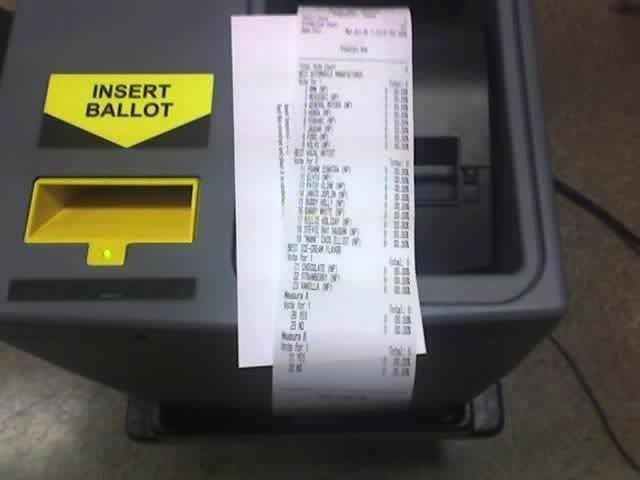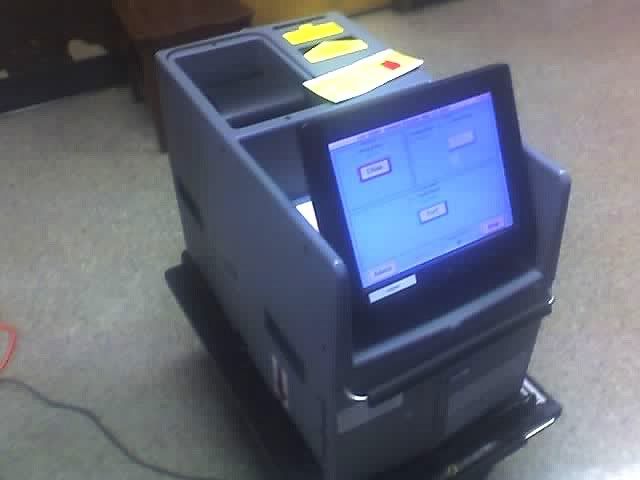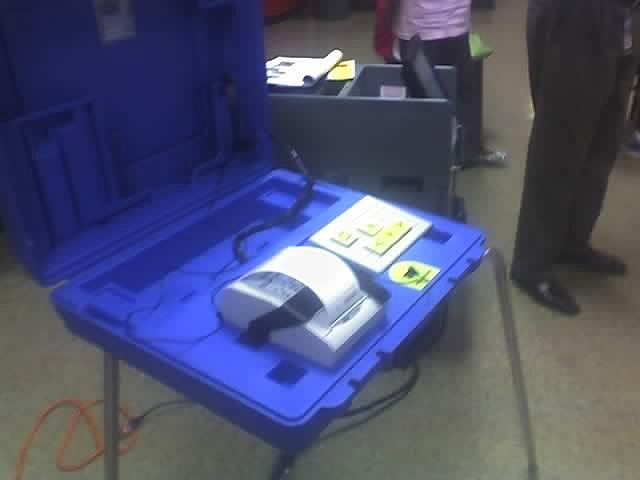From the Whittier Daily News.
SANTA FE SPRINGS - The computer world is coming to voters for the first time in Los Angeles County.It means less chances of "over voting" and a new way for the blind and visually impaired to vote without assistance.
The $25 million InkaVote Plus system was unveiled by county election officials Thursday at the Registrar-Recorder's new 100,000-square-foot warehouse in Santa Fe Springs.
"This is the largest rollout of new voting equipment ever in America," said Conny McCormack, registrar-recorder/county clerk. "We never had voting equipment that had intelligence at every one of the voting locations. We're going to have that for the first time."
Sounds neat huh? No more mistaken ballots with overvotes, no more blank ballots (which accounts for about 7% of the 3 millions ballots cast each election in L.A. County)... but is that all there is to it?
Not hardly...
Continued:
Each of the 5,029 voting precincts in the county will receive a precinct ballot reader and an audio ballot booth. The ballot readers will tip off voters if they mistakenly voted for two candidates for the same office, or if their ballot wasn't marked.When voters turn in their paper ballots, they will submit the ballot into the ballot reader. If there is no problem, the ballot goes into the ballot box.
But if a problem is detected, the ballot will pop back out and a small piece of paper will tell the voter what the
problem is. The voter can then go back and re-vote.
I happen to be a pollworker, and have been for the past several years including the 2004 Presidential election. LA and California are about as Blue as you can get, so we have very few seriously contested races most of the time.
Yesterday as part of my pre-election training, I along with dozens of others received my first look at the new election equipment - ballot readers and audio voting booth - that we'll be using this November in L.A. County.
The first issues is clearly the ballot reader itself. Since 2000 we switched away from punch-cards to the Inka-vote system, which uses as marker to indicate which item a person is voting for on a paper ballot. No more hanging chads for us. But the marker system itself isn't perfect, marks can be smeared, ballots can be torn or crumpled, and voters and mistakenly mark on than one candicate for the same race (an overvote).
One of the main problem in Florida which often goes undiscussed, was the confusion created by the overly complex butterfly ballot and overvotes. Most of the contested votes in that election were undervotes, where the voter didn't not completely and clearly mark their choice (undervotes), the Supreme Court eventually ended the recounting while Bush still retained a slim lead, and even if they hadn't done so and the recounting of ballots as dictated by Gore's selective targeting of undervotes in problem counties has continued - he still would have lost.
But... a post election study in 2001 by the National Opinion Research Center (which was most famously referenced via Michael Moore's Farenheit 9/11) found that if either the more generous standard for determining voter intent used in Palm Beach Counter or overvotes had been considered Gore would have won Florida by 25 and 400 votes respectively. This study was far from conclusive and has been widely criticized, but in 2006 Professor Lance Dehaven-Smith of Florida State University performed an even more indepth study of the overvotes and found that in many, many cases - the voter also included a write-in candidate..
Apparently after being confused by the ballot itself, making an incorrect choice and attempting to correct that choice by voting the opposite way, many thousands of voters wrote their choice in the margins just to make certain it would be noted correctly. Unfortunatly invalidated their ballots and they were cast aside. Professor Dehaven-Smith found 46,000 unambigous overvotes with write-ins for Gore, but only 17,000 write-ins for Bush which would have given Gore an 30,000 victory except that none of those ballots were counted.
The new Ballot Reader being used in LA County - and I strongly suspect elsewhere - is intended to solve that problem. No longer will an entire ballot be invalidated by an overvote -- only the the specific race with multiple votes shown will be ignored.
The machine sits atop the ballot box, the voter inserts their ballot where it is scanned and analysed for errors. If the ballot is either blank or an overvote is detected it is rejected and a small printer indicates what the problem is, including exactly which race received multiple votes.
The voter has the option of allowing the ballot to be accepted anyway - if the problem happens to be in a race they don't care about and they don't have to time to fill out a completely new ballot. Voters can also choose not to have their ballot scanned at all and have the poll workers place it directly in the ballot box.
Overall to me this seems to be a good deal, one that is clearly intended to make the voters comfortable with the new system. The Ballot Reader does not tabulate the votes, although it does have that capability Country-Registrar McCormack has requested that featured be disabled - for now.
Unresolved issues:
Since the new ballot readers don't do vote tabulation (owing at at least partially to the fact that voters can opt-out of using the reader completely) tabulation has to still be performed at the County's main offices in Norwalk by voting machines at those locations. Physical and Software Security concerns for tabulators which have grown in the wake of various Deibold Whistleblowers from Stephen Heller to Ion Sancho and William Singer remain, particularly after the dramatic Princeton Deibold Hacking Demostration.
 The Reader contains a printer, but when a ballot is accepted without errors, it prints nothing. There is no receipt or validation of exacly what the voter entered, although this is clearly possible since the very same machine is capable of printing an error report specify the exact problem when the voter makes multiple selections. (When activated it prints a "Zero Report" which shows that no ballots have been counted - sample shown at right)
The Reader contains a printer, but when a ballot is accepted without errors, it prints nothing. There is no receipt or validation of exacly what the voter entered, although this is clearly possible since the very same machine is capable of printing an error report specify the exact problem when the voter makes multiple selections. (When activated it prints a "Zero Report" which shows that no ballots have been counted - sample shown at right)
I have 12 years experience as an IT professional working for a Defense Contrator under C2 Level Security which is the same level of protection (Greater than Top Secret: Special Access Required) as the NSA's Domestic Terrorist Surveillance program. We were all required to attend briefings by the FBI on counter-espionage and how to protect information security in order to retain our security clearances. From that perspective I can state that any machine with insuffienct security in place - including the ballot readers themselves -- which had no passcode security blocking access to it's ADMIN functions (at least not during the DEMO, which may change before the actual election) - are completely vulnerable to anyone malicious and resourceful enough. This brings us to the second portion of the new equipment we were shown yesterday...
This machine is essentially an automated audio selection system much like what the type you encounter when calling most customer service numbers on your phone ("If you'd like to make a payment dail '1'. If you'd like to speak to an operator... give up") but a lot more useful.
The system is linked (via serial cable) to the ballot reader which includes a touch screen to select from one of eight available languages including Cantonese, English, Japanese, Korean, Mandarin, Spanish, Tagalog and Vienamese.
You don't have to be able to read or see to use this machine and vote. Simply by listening to the audio instructions you can easily scroll through the ballot and make your selections one by one. We were shown how this works and it does so quite well. Once the voter has completed their selections, the audio booth prints it's own ballot summarizing their choices.
This is all fairly nifty, and I'm sure will give the Red-States a mild hemorage as they consider the implications that people who don't read or speak English, but only Tagalog will have full access to vote.
Unresolved issues:
This machine contains a roll of only 25 ballots, the first of which prints out automatically on boot-up and has to be discarded leaving on 24. My precinct is in a neighboring filled with a large number of Spanish, Vietnamese and Korean speakers, but with only 24 Voice ballots available my inclination as poll worker would be to direct most of these people to use the normal Inkavote system with a multi-lingual printed ballot rather than the audio machine which would be more absolutely essential for blind or visually impaired persons. The Audio Booth happens to also be our handicapped access booth, but for sighted person I would still recommend they use the paper Inkavote, simply because of such a small number of available ballots. Unfortunely I've almost never seen a blind person at an election, probably because - well, it's an oxymoron - but now, they too can vote and IMO should be encouraged to do so.
 Also there is no apparent method for the person using the Audio booth to confirm that the choices they made through it's system are actually what is contained on the ballot it prints. There are no open ports on the Audio booth, but it does connect to the ballot reader via a serial cable and the reader itself contains a network (TCP/IP) port. I didn't see any other access point, but from what I could tell the reader is the brains of the outfit and operates the audio booth as if it were a remote device. Any software glitches or "patches" applied to the reader could completely disrupt or "vote swap" what the audio booth actually prints without any way to detect the switch.
Also there is no apparent method for the person using the Audio booth to confirm that the choices they made through it's system are actually what is contained on the ballot it prints. There are no open ports on the Audio booth, but it does connect to the ballot reader via a serial cable and the reader itself contains a network (TCP/IP) port. I didn't see any other access point, but from what I could tell the reader is the brains of the outfit and operates the audio booth as if it were a remote device. Any software glitches or "patches" applied to the reader could completely disrupt or "vote swap" what the audio booth actually prints without any way to detect the switch.
To my mind the primary way to resolve most of these issues is simply to print a receipt with a summary of the votes cast, a ballot ID number and a phone number for the voter to call and verify that their votes were indeed recorded as they intended. As a portion of HAVA (The Help America Vote Act) a system similar to this has been in place for several years involving provisional ballots, where voters are given a receipt and 40 days after the election can call to verify if their provisional ballot was actually counted.
Right now, Inkavote paper ballots are not uniquely numbered, so once your votes enter the ballot box there is no way to specifical identify who voted for what, but this could easily be implmented particularly with the new ballot reader system - and frankly SHOULD BE MANDATORY.
E. J. Dionne of the Washington Post seems to agree:
Sometimes, paranoids are right. And sometimes even when paranoids are wrong, it's worth considering what they're worried about.I speak here of all who are worried sick that those new, fancy high-tech voting systems can be hacked, fiddled with and otherwise made to record votes that aren't cast or fail to record votes that are.
I do not pretend to know how large a threat this is. I do know that it's a threat to democracy when so many Americans doubt that their votes will be recorded accurately. And I also know that smart, computer-savvy people are concerned about these machines.
The perfectly obvious thing is for the entire country to do what a number of states have already done: require paper trails so that if we have a close election or suspect something went wrong, we have the option to go back and check the results.
Apparently a set of both Republicans and Democrats in the House feel the same way.
So it is heartening that a diverse group -- Republicans and Democrats, liberals and conservatives -- in Congress has proposed legislation to give everyone, even the supposedly paranoid, confidence that our elections are on the level.The bill has been pushed by Rep. Rush Holt (D-N.J.), with strong support from Reps. Tom Davis (R-Va.) and Tom Cole (R-Okla.). It has 219 co-sponsors, which happens to be a majority of House members.
The bill requires that voting machines produce a permanent paper record that voters themselves can verify. It requires random, unannounced hand-count audits in 2 percent of all precincts to make sure the machines recorded votes properly.
It prohibits connecting any voting machine component to the Internet and bans political and financial conflicts of interest among manufacturers, test laboratories and political parties. It also includes protections for voters with disabilities.
The Ballot Reader and Audio Booth system we were shown were manufactured by Election Software & Systems in connection with Unidyn. ES&S, is a company that used to have Chuck Hagel as one it's board members before he was elected to the Senate in an election which used ES&S machines. (This fact of course isn't proof of skull-duggery, it's just stinks to high heaven - lese sulfer is what our electoral process needs, not more)
But what is an even larger issue than the integrity of electronic machines, even these which may appear relatively harmless compared to full-on Deibold touch-screens (which are already being used in selected portions of L.A. County) is the issue of faked registrations, employer intimidation and voter disenfranchisement.
As shown by Robert F Kennedy Jr. - in 2004 heavily democratic precincts among battlegrond states were specifically targeted and people improperly dropped from the rolls forcing them to vote provisionally where many of their ballots were incorrectly discarded. Whether or not this actually changed the outcome of the election is besides the point - it's wrong and we all need to do everything we can to fight back against it.
Too many people in the nation have fought hard and died for the right to vote to have it stolen away in dead of night.
All of this is an issue that needs more focus, even though the GOP has taken some major hits in recent weeks as a result of Foley-Hastertgate - the new reports of North Korea's Nuke is likely to re-awaken the security moms, while Olberman's report last night that Conseravtive Evangelical's remain undetered and well prepared to hold their noses as they continue to slavishly vote for Republicans against their own best interest... Democrats can not afford to get too comfortable.
I am a commited partisan, but this is not a partisan issue - it's an American issue and needs to be addressed as such.
I hope other Dkos poll workers or election officials from various states - particularly the highly contested districts - will also contribute what they've seen and issue that remain to be addressed so that we can help each other form stratagies to protect all our votes, left and right alike.
Vyan

